RSMITH
Greenie
Hello Everyone,
I am new to this website and really excited to be a member. I have recently gotten into precious metal, meteorite, treasure, and fossil prospecting (more so on the precious metals at this point in time). I have read about 10 different books on gold recovery, I have watched 1000 youtube videos, and I also have several years worth of Geology classes from the University of Colorado @ Boulder. My primary major was in Environmental Science but I focused a large majority of my classes in the geology of earth and alien terrestrial environments. This knowledge has really helped me to make more efficient use of my time, however, I realize that I have a long way to go. I have not been finding too many "nuggets," but rather, I have found several rock specimens with wirey metal running through them (some gold, some silver). I was blessed with fantastic vision and I have also ID'd a lot of them under a 40x magnification microscope. So, with all that being said:
I recently found a rock specimen that I am having a difficult time identifying. Utilizing my "somewhat decent" knowledge base, I followed a small drainage basin down to where the ground leveled out and where there were signs of meandering water (now dry). I sought out the lowest depression in the locality and dug down about a foot in the dirt. Before I even started to pan the dirt, I looked down into the hole and saw something glinting in the faint light, 12 inches below the surface.
I pulled the specimen out and immediately thought that I had found a gold nugget, seemingly due to the sheer weight and apparent density of the object. When I washed it off however, I saw that it was a very unique "nugget/rock/specimen/?" The disorienting characteristics are: resembles pyrite in many ways, but much heavier/denser than any pyrite I have felt/seen; The yellow portions are brilliant yellow and do not seem to change under different angles of light; There are also brilliant reds, a little brilliant purple, and glints of silver that are sporadically apparent; *This next characteristic would typically be a nail in the coffin, but keep reading... I also noticed that the specimen had a small portion of beautiful crystal clusters attached to the main nugget/rock. Now, I know that 99 times out of 100, gold will not be affiliated with this type of specimen; Due to the fact that beautiful crystalline structures are generally indicative of a lack of sufficient pressure, mandatory to produce gold veins. However, The colors of this object are unlike any pyrite specimen that I have seen, or have been able to find on the internet. Also, under a microscope of 40x, the crystalline structure of the surface is not structured like a typical pyrite specimen either. Now, there are portions of it that I can tell are pyritic in nature, but a good majority of the surface (at a microscopic level is rounded and has a rather "lumpy" and has precious metal-like appearance. A good portion of the specimen does not change colors to the purples, greens, and browns (as typical pyrite does) when rolled around under a light source, but some parts of it do. And once again, the specimen itself is actually much heavier than any piece of pyrite that I have ever seen. The colors of the surface are also referential to gold and rose gold more so than pyrite. I have included some pictures below and would love some other opinions on this. I also figured out a way to take pictures on my phone through my small microscope (with very steady hands), and I have included those as well. Thank you so much for your time and I look forward to being a member on this website.
*Also, at this point in time, I do not have a sufficient scale in order to calculate the exact density. Before I go to all that trouble, I thought I would put this out to see if any experts can make a visible distinction or hypothesis.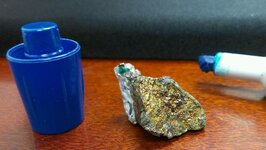
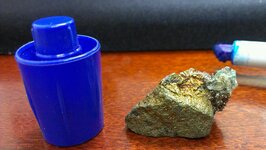
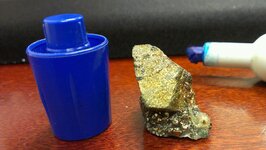
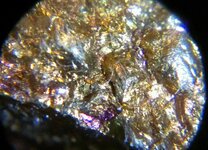
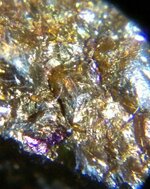
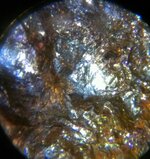
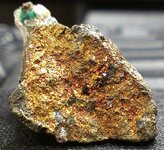
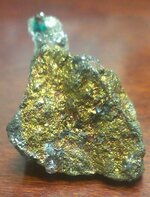
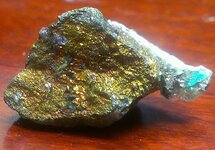
I am new to this website and really excited to be a member. I have recently gotten into precious metal, meteorite, treasure, and fossil prospecting (more so on the precious metals at this point in time). I have read about 10 different books on gold recovery, I have watched 1000 youtube videos, and I also have several years worth of Geology classes from the University of Colorado @ Boulder. My primary major was in Environmental Science but I focused a large majority of my classes in the geology of earth and alien terrestrial environments. This knowledge has really helped me to make more efficient use of my time, however, I realize that I have a long way to go. I have not been finding too many "nuggets," but rather, I have found several rock specimens with wirey metal running through them (some gold, some silver). I was blessed with fantastic vision and I have also ID'd a lot of them under a 40x magnification microscope. So, with all that being said:
I recently found a rock specimen that I am having a difficult time identifying. Utilizing my "somewhat decent" knowledge base, I followed a small drainage basin down to where the ground leveled out and where there were signs of meandering water (now dry). I sought out the lowest depression in the locality and dug down about a foot in the dirt. Before I even started to pan the dirt, I looked down into the hole and saw something glinting in the faint light, 12 inches below the surface.
I pulled the specimen out and immediately thought that I had found a gold nugget, seemingly due to the sheer weight and apparent density of the object. When I washed it off however, I saw that it was a very unique "nugget/rock/specimen/?" The disorienting characteristics are: resembles pyrite in many ways, but much heavier/denser than any pyrite I have felt/seen; The yellow portions are brilliant yellow and do not seem to change under different angles of light; There are also brilliant reds, a little brilliant purple, and glints of silver that are sporadically apparent; *This next characteristic would typically be a nail in the coffin, but keep reading... I also noticed that the specimen had a small portion of beautiful crystal clusters attached to the main nugget/rock. Now, I know that 99 times out of 100, gold will not be affiliated with this type of specimen; Due to the fact that beautiful crystalline structures are generally indicative of a lack of sufficient pressure, mandatory to produce gold veins. However, The colors of this object are unlike any pyrite specimen that I have seen, or have been able to find on the internet. Also, under a microscope of 40x, the crystalline structure of the surface is not structured like a typical pyrite specimen either. Now, there are portions of it that I can tell are pyritic in nature, but a good majority of the surface (at a microscopic level is rounded and has a rather "lumpy" and has precious metal-like appearance. A good portion of the specimen does not change colors to the purples, greens, and browns (as typical pyrite does) when rolled around under a light source, but some parts of it do. And once again, the specimen itself is actually much heavier than any piece of pyrite that I have ever seen. The colors of the surface are also referential to gold and rose gold more so than pyrite. I have included some pictures below and would love some other opinions on this. I also figured out a way to take pictures on my phone through my small microscope (with very steady hands), and I have included those as well. Thank you so much for your time and I look forward to being a member on this website.
*Also, at this point in time, I do not have a sufficient scale in order to calculate the exact density. Before I go to all that trouble, I thought I would put this out to see if any experts can make a visible distinction or hypothesis.









Upvote
0






